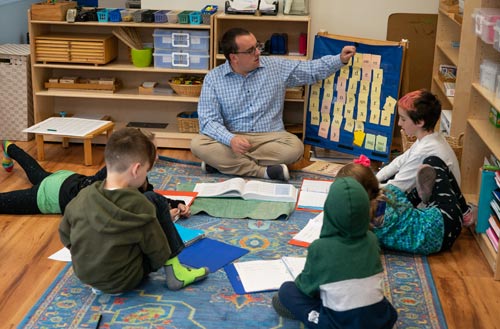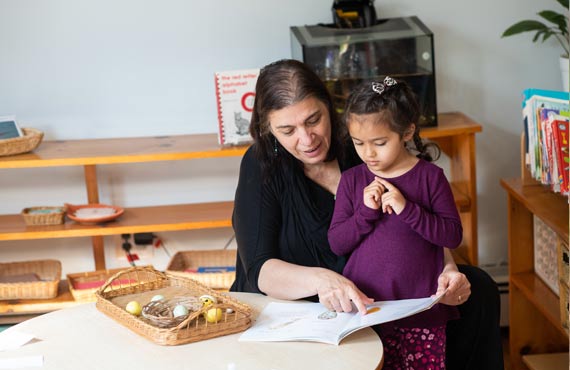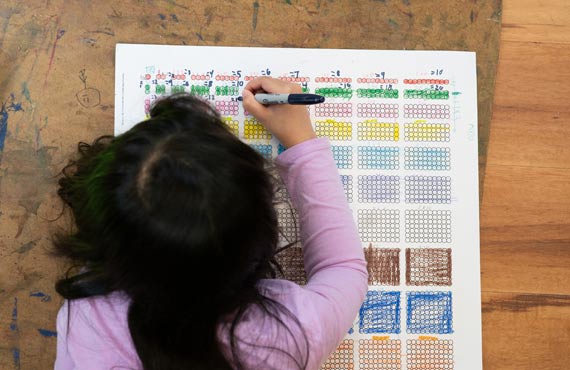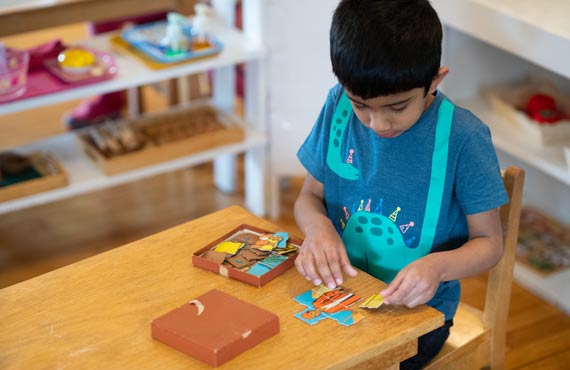
"To stimulate life and then leave it free to develop, to unfold. That is the first task of the educator."
Maria Montessori
A Montessori Education
The basic idea in the Montessori philosophy of education is that every student carries unseen within them the person they will become. In order to develop intellectually, they must have freedom. This freedom is achieved through order and self-discipline. The world of the student, say Montessori educators, is full of sights and sounds which at first appear chaotic. From this chaos the student must gradually create order, and learn to distinguish among the impressions that assail their senses, slowly but surely gain mastery of themselves and their environment.
Dr. Montessori has recognized that the only valid impulse to learning is the self-motivation of the child. Children move themselves toward learning. The teacher prepares the environment, directs the activity, functions as the authority, offers the student stimulations, but it is the student who learns, who is motivated through work itself (not solely by the teacher's personality) to persist in a given task. If the Montessori studentis free to learn, it is because she has acquired from her exposure to both physical and mental order an "inner discipline." This is the core of Dr. Montessori's philosophy. Social adjustment, though a necessary condition for learning in a school room, is not the purpose of education. Patterns of concentration, stick-to-itiveness, and thoroughness, established in early childhood, produce a confident, competent learner in later years. Schools have existed historically to teach children to observe, to think, to judge. Montessori introduces children to the joy of learning at an early age and provides a framework in which intellectual and social disciplines go hand in hand.
The following are the elements of a Montessori classroom and the foundation of the Montessori educational philosophy.
Prepared Environment
Dr. Montessori developed what she called the “prepared environment.” The prepared environment is established by an adult and is designed to facilitate maximum independent learning and exploration for the student. The Montessori prepared environment provides students with the opportunity to work on activities of their own choice at their own pace. As a result, they experience both freedom and self-discipline in a space designed to meet their specific developmental needs. At every step of learning, the teaching material is designed to test the student’s understanding and correct their errors. The structure of Montessori learning involves the use of many materials with which the student may work individually.
The Role of the Teacher
The teacher in a Montessori classrooom is a model of what the student can eventually become and the preparer of the environment for the student. The bond between the teacher and the student is based on respect and trust, which boosts the student's self confidence. Since the students have learned to work independently in the prepared environment, the Montessori teacher is then able to observe a student individually. An observant teacher is then able to efficiently facilitate a student's individual developmental, social and academic needs. The Montessori teacher also facilitates classroom activities, carefully planning the environment, and helps progress from one lesson to the next.
The Multi-Age Environment
Students are grouped in mixed ages, typically in a three year age span based on the child's development. Students in a mixed age classroom are challenged according to their individual ability and through constant interaction with other students. The Montessori multi-age grouping is a key variable in creating a positive environment for individual and collaborative learning and social development. The benefit of this three-year age grouping is that students learn from each other: the younger ones learn from the older ones; the older ones demonstrate their mastery of an area by teaching the younger ones what they know. Students have the opportunity to learn, grow, and explore at their own pace, gaining experience and understanding—and ultimately becoming self-directed learners. Students learn to negotiate, cooperate, and accept ideas other than their own. This multi-age grouping also has a social benefit for student: they develop their social skills in an environment that mimics social and family positions. Even an only child can have the experience of being the youngest, middle, and oldest child in the classroom family.
Montessori Resources & Articles
Maria Montessori Blog
American Montessori Society
Association Montessori International
Montessori Science
Videos of Interest
The Montessori Method; Education for Life
Montessori: Creativity Unleashed
Why Choose Montessori?
Books of Interest
The Absorbent Mind (Heny Holt & Co., 1995), by Dr. Maria Montessori
Montessori Madness! A Parent to Parent Argument for Montessori Education (Sevenoff, 2009), by Trevor Eissler
Montessori: The Science Behind the Genius (Oxford University Press, 2005), by Angeline Stoll Lillard
Discovery of the Child (Fides, 1967), by Dr. Maria Montessori
Drive (Penguin, 2011), by Dan Pink
A Whole New Mind (Penguin, 2006), by Dan Pink
Brain Rules (Pear Press, 2009), by John Medina
The Schools Our Children Deserve: Moving Beyond Traditional Classrooms and “Tougher Standards” (Houghton Mifflin, 1999), by Alfie Kohn
Punished By Rewards: The Trouble with Gold Stars, Incentive Plans, A’s, Praise, and Other Bribes (Houghton Mifflin, 1993), by Alfie Kohn


